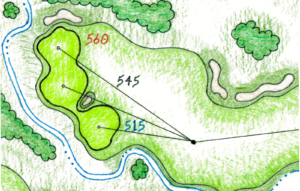Drawings
Three Sticks at Loch Lomond
The Loch Lomond property is where the idea for Three Sticks was born. The Loch Lomond Golf Course in Flint, Michigan was a nine – hole, 2600 – yard, Par - 34 golf course that had gone out of business and the property was put up for sale. It was (and still is) a beautiful piece of land within a seasonal floodplain, with a stream running through it, a small handful of ponds, and noticeable elevation changes. The property comprises about 53 acres, and is bordered by a major thoroughfare on the West, a train track/utility easement on the East, a residential neighborhood to the South and other businesses North.
The Three Sticks – style course we envisioned on this site featured a full – sized range, and measured 6140 yards for a Par of 69 (of the six holes laid out, there were three par – 4’s and one par – 5, which created a Total Par of 23 for each Six. A Par – 69 course of this distance is comparable to a Par - 72 course of 6600+ yards). Great care was used to utilize the natural features found on site (i.e. the water features, elevational changes, and vegetation already in existence). Here is a rendered drawing of what it could be:
Three Sticks along a stream
The drawing seen below is a demonstration of what a Three Sticks – style course might look like if laid out along a stream. After drawing it up initially (as seen below), the overall design of the course was “tweaked” to more efficiently use the land available. Five yards were added to every hole (except # 18—it’s already long enough!), a parking lot for the clubhouse was added, as well as a maintenance facility and a full sized range. When allowances were made for the proper safety corridors, the overall acreage was 65 acres—just under 60 without the range. The scorecard seen within the drawing is before those changes, so it shows only 6625 yards, whereas the final version is just over 6700 yards (Par 72). This drawing was then used as a basis for a very large model (it measured over six feet long) that was taken (to wide acclaim and many accolades) to the Golf Industry Show in Orlando, Florida in January of 2020.
Three Sticks on a 50 – acre square?
After developing the drawings seen above, our design staff was challenged to see if a viable alternative could be drawn up for a Three Sticks - style course on a 50 – acre parcel. The challenge was enhanced to include a requirement that the fictitious parcel of land was a perfect square (do the math…that’s 1475 feet on each side). The obvious challenge here is that there is not enough room for a Par – 5 along any one of those sides. This required that the par -5’s be placed either on a diagonal across the middle, or, designed with a severe dogleg.
Although the challenge was met with the drawings seen below (one is a 6165 – yard Par - 69 while the other is a 6460 – yard Par – 72), our staff was not completely satisfied with the result. There was barely enough room for a Clubhouse and Putting Green, and patrons would probably have to park on the street surrounding the property. Furthermore, in some places, significant tree plantings and/or earthmoving would have to be carried out to comply with standard safety corridor requirements (please note that there is room for a Maintenance Area on both sites, but those areas were not shown on the drawings). You may also notice that many of the Green Complexes are set up in a linear fashion (one behind another behind another)--a less than desirable necessity for safety corridor purposes.
Green Complexes
As you know from previous pages, a typical Three Sticks-style golf course will have only six holes—with three flagsticks per hole. By a matter of pure coincidence, there are six basic types of green complexes* that can be created for holes like this. They are (click on each for representative drawings):
* A “green complex” is all the components that make up the area surrounding the cup. These components include the shape and undulations of the green surface itself; the bunkers, water features, and/or other hazards nearby; the tree and shrub vegetation in the vicinity of the green; and the topography, mounding, and types of grasses used off the green surface.




























